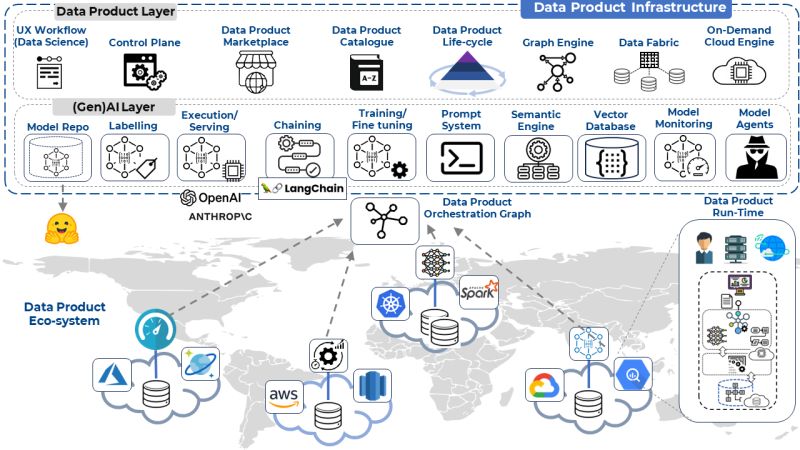At Dataception Ltd, we've developed a comprehensive architecture that leverages Large Language Models (LLMs) and transformer-based AI models to revolutionize the development, design, and operation of data products. This innovative architecture is segmented into three layers, each contributing to a seamless integration of AI capabilities with data product management. Here’s a closer look at the architecture and how it drives business value.

Data Product Layer
Business-Facing Data Product Creation:
- Persona-Driven UX: Designed for data scientists and analysts, this feature facilitates rapid prototyping, experimentation, and sandboxing with one-click deployment, all in front of the business.
- Full Control Plane: Manage and operate all data products through a single pane of glass, providing comprehensive oversight.
- Navigable Marketplace: A user-friendly marketplace to quickly find and execute data products across the organization.
- Data Product Catalogue: A searchable catalogue containing metadata for each data product, including APIs, definitions, datasets, and configurations, enabling fast reuse.
- Data Product Lifecycle: Utilizing our Data Product Pyramid process, we cover everything from value definition, ideation, and prototyping to building, operating, and retiring data products.
- Hybrid Graph Engine: An interactive, navigable graph of data products via APIs, offering visibility and execution of business processes.
- Data Fabric: Allows full metadata usage and lifecycle management, facilitating data reuse for each product without physical duplication.
- Cloud Engine: Dynamically runs data products across all cloud providers and on-premises environments, including Kubernetes and virtualization, while abstracting the underlying infrastructure.
GenAI Layer
Model Repository:
- Local & External Persistence: Store models locally and access external repositories like Hugging Face.
Labeling & Human Feedback:
- UX-Based Labeling & Correction: Provides an interface for labeling and correcting AI models, such as Named Entity Recognition (NER) and other generative use-cases.
Serving & Execution:
- Dedicated Data Product Run-Times: Deploy models to specific data product run-times for LLM use-cases and generalized containers/SaaS, supporting cross-functional use-cases.
Chaining:
- Complex Chaining of LLMs: Integrate LlamaIndex and LangChain for sophisticated data product run-times.
UX-Based Training/Finetuning:
- On-Demand GPU Compute: Train and fine-tune small and large models using an intuitive user interface and GPU resources.
Prompt System:
- UX-Based Component: Deploy prompts into chains or as standalone data product run-times.
Semantic Engine:
- Map Taxonomies & Ontologies: Translate between LLM corpora and natural language inputs/outputs.
Vector DB:
- Embeddings Persistence & Search: Store and search embeddings efficiently.
Model Monitoring:
- Monitor Scores & Health: Track metrics like F1, precision, recall, and data quality to ensure accuracy and reduce hallucinations.
Model Agents:
- Autonomous/Semi-Autonomous Agents: Automatically execute complex, goal-oriented tasks using LLMs.
Data Product Ecosystem
Analytics-Based Data Products:
- From Simple Metrics to Complex Models: Deploy a range of analytics, from basic metrics to sophisticated models like LLMs, Monte Carlo simulations, and graph analyses. These are deployed as data product run-times across a heterogeneous technology estate.
Enhancing the Architecture
The GenAI and Data Product Architecture we've developed is nothing short of revolutionary. By combining transformer-based AI models with a comprehensive, three-layered approach, we ensure a seamless blend of user experience, AI efficacy, and unparalleled flexibility. Rapid prototyping directly in front of the business is groundbreaking, enabling swift iterations and alignment with business goals.
The GenAI layer’s capabilities, such as chaining and UX-based fine-tuning, open new horizons for AI, allowing dynamic and contextual responses with on-demand GPU compute. The emphasis on a holistic ecosystem — from model monitoring to semantic engines and prompt systems — promises not just a leap in efficiency but also heralds the future of AI-driven data products. Our architecture paints an invigorating picture of the future of data management and AI integration, showcasing limitless possibilities.
It's crucial to remember that technology should serve people and the business. Workshops with business leaders often reveal valuable analytics (data products) that can drive revenue or improve efficiencies. However, the implementation phase can be slow and cumbersome. Our approach aims to speed up, de-risk, and reduce costs while connecting business ideation with implementation and operation seamlessly.
This architecture is a testament to years of evolving product thinking and architecture design. It doesn't just stop at data provisioning but goes beyond to deliver true business-facing analytics with comprehensive run-times, configurations, and visualizations. Our goal is to support organizations in a flexible, scalable, and cost-effective manner, whether on-premises, in the cloud, or at the edge.
Conclusion
The GenAI and Data Product Architecture at Dataception Ltd represents a significant advancement in how data products are developed, managed, and deployed. By integrating state-of-the-art AI capabilities with a robust data product framework, we provide a versatile and powerful solution for modern data challenges. This architecture not only accelerates the delivery of data products but also ensures they are aligned with business objectives and can adapt to evolving needs.
Call to Action
If you're interested in learning more about this architecture and how it can transform your data strategy, stay tuned for our upcoming webinar. Join us as we delve deeper into the details and showcase the full potential of GenAI and data product integration.

